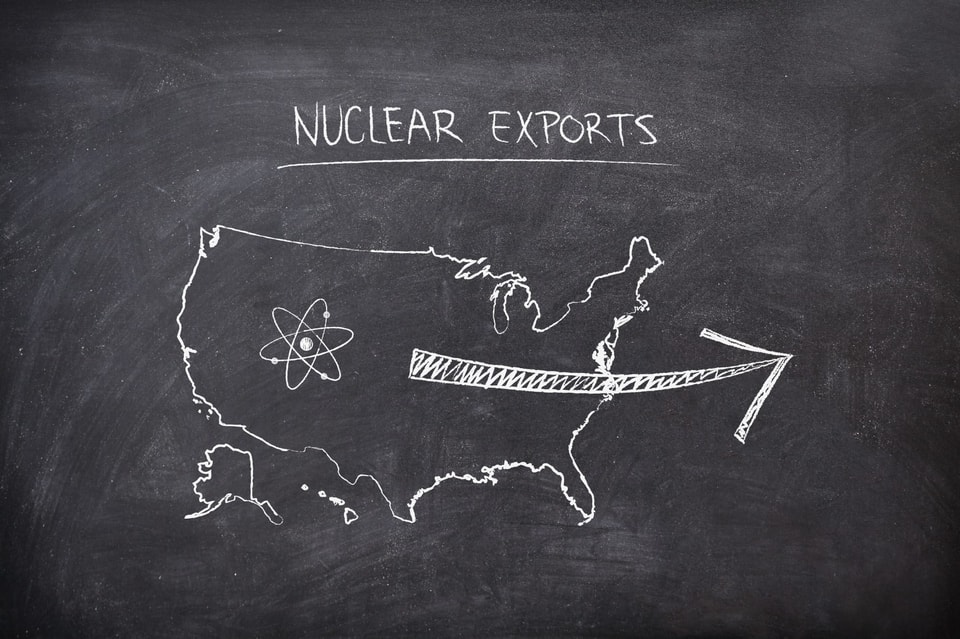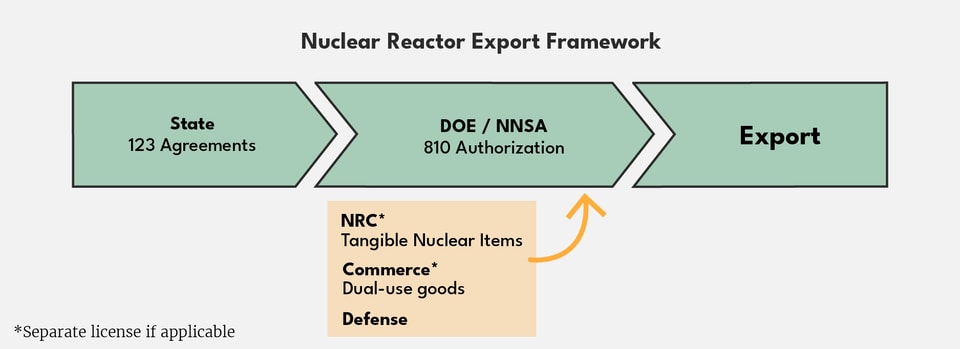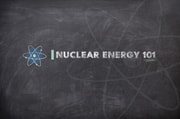Blog Published January 16, 2025 · 8 minute read
Nuclear Reactor Exports 101
Alan Ahn & Rowen Price

As we race towards building out advanced reactors at home to meet skyrocketing demand for clean and reliable energy from our power and industrial sectors, we must be mindful that the vast majority of market opportunity for US advanced nuclear technology will be overseas. More countries are joining the pledge to triple global nuclear capacity by 2050, consistent with projections that the global market will potentially triple by midcentury. At the same time, massive growth in data center energy use from artificial intelligence and geophysical trends are poised to increase international demand even further. In other words, the commercial stakes are enormous.
The global race for advanced nuclear has already begun. To dominate our global competitors, a concerted US effort is needed to push new technology across the finish line—and make it accessible to global partners. This blog unpacks the US nuclear energy exports framework, identifies opportunities for federal action on nuclear energy cooperation, and highlights why US export competitiveness matters to national goals. For more information on advanced reactors and answers to frequently asked questions, check out 20x35.
Why (and How) the Federal Government Must Act
Our primary competitors in overseas markets are state-owned enterprises that bring the full weight and capabilities of their respective governments to win export deals. Thus, the US nuclear industry is not simply pitted against private firms, but is in competition with nations.
With so much on the line for core US national interests, the federal government has a crucial responsibility to level the playing field, specifically by:
- Instituting a Whole-of-Government Approach and Strategy: Our state-backed competitors are in full lockstep with their respective national governments, leveraging the highest organs of the state to court and engage client countries. For example, Russia has allegedly offered side concessions (i.e., arms transfers) as part of its comprehensive export packages. Given this state of competition, it is urgent that the federal government implement a holistic and integrated civil nuclear export strategy that is coordinated at the highest levels.
- Enabling Competitive Export Financing Packages: Arguably, our competition’s most pivotal advantage is the ability to bring government-backed financing to export deals, often at generous and preferential terms. Addressing challenges faced by US export financing entities and enhancing their toolkits, particularly in the context of their upcoming reauthorizations, is an absolute must. Federal agencies such as Export-Import Bank (EXIM), US International Development Finance Corporation (DFC), and US Trade and Development agency (USTDA) can play complementary roles in developing strong financing support for US civil nuclear exports.
- Advance Engagement with Country Markets: The federal government must play a key role in engaging prospective international partners, especially where there is no immediate commercial incentive for industry to do so. Expanding federal capacity building and workforce development programs strengthens interpersonal ties and better positions the US in these future markets, lest we allow China and Russia to seize these opportunities.
The US Nuclear Export Framework

The United States has a complex set of regulations, authorizations, and licenses in place to export nuclear technology, information, and material while preventing proliferation and ensuring commercial information protection. This ecosystem includes many parts of the interagency. Here’s who’s involved, and why their role matters:
Department of State
The Department of State (DOS) focus is on fostering relationships with partner countries and supporting their readiness for nuclear energy. DOS negotiates and implements 123 Agreements with other countries to allow exports as well as information-sharing and joint research. These overarching agreements are a fundamental requirement before any vendor seeks authorization or licenses for specific transfers, as they dictate the broader framework for cooperation. The US has twenty-five 123 Agreements, and more memoranda of cooperation, but Russia and China are surging ahead in concluding civil nuclear cooperation agreements. 123s take an average of 400 days to negotiate and conclude.
The State Department also leads the Foundational Infrastructure for Responsible Use of Small Modular Reactor Technology (FIRST) program, which helps potential buyer countries prepare to finance, build, and deploy advanced reactors. These efforts foster host country readiness that is key for US export feasibility.
Department of Energy/National Nuclear Security Administration
Once a 123 Agreement is in effect between the US and the importing country, a nuclear developer can initiate the process for transferring specific reactor technology to a customer overseas. At the Department of Energy (DOE), the National Nuclear Security Administration (NNSA) is the semi-autonomous agency under DOE that leads international engagement on nuclear security and nonproliferation. NNSA is responsible for processing “Part 810” authorizations for nuclear energy technical assistance and information sharing to other countries. Particularly for advanced nuclear technologies, secure international information-sharing is key for innovation and deployment readiness. Authorizations, which differ depending on the sensitivity of the activity and destination in question, take an average of 9 months to conclude.
DOE’s Office of Nuclear Energy also directly engages in international cooperation activities with current and embarking nuclear energy nations on several continents to manage and grow bilateral and multilateral relationships. These efforts help influence partner nation’s nuclear energy policies and promote collaboration with the US nuclear industry.
Department of Commerce
Additionally, the Department of Commerce (DOC) focuses on supporting US commercial interests while ensuring national security. DOC’s Bureau of Industry and Security regulates export of “dual-use” goods, which can be used for both peaceful and military purposes. When it comes to exporting nuclear technology, oversight is needed to verify that this technology is going to be used for civilian applications. If a vendor seeks to export dual-use goods, they will need a license approval from DOC in addition to the Part 810 authorization. License approvals take 90 days on average.
Nuclear Regulatory Commission
The Nuclear Regulatory Commission (NRC), as the regulator of civilian nuclear material and facilities in the US, has jurisdiction over regulations in 10 CFR Part 110, which relates to the transfer of “tangible” nuclear items including nuclear material and components. A US entity exporting tangible nuclear items will need approval from the NRC in the form of an export license. These approvals can take months to over a year to complete.
The NRC may also engage internationally with peer regulatory agencies and share best practices to meet the licensing and oversight needs of advanced reactors sold abroad.
Department of Defense
The DoD plays an advisory role in the export approval process. The sensitivity of nuclear technology and ties to national security necessitate additional buy-in, and so the DoD can advise on specific concerns about exporting a technology or sharing information.
International Obligations
When considering reactor exports from the US, vendors need to be aware of the additional international obligations for many countries. Most countries have legally binding agreements with the International Atomic Energy Agency (IAEA) to implement activities and design features to verify peaceful use of nuclear technology and materials—also called the international safeguards system. Therefore, vendors must prepare their designs to meet this additional layer of regulatory requirements if they want to export to these countries. In addition, the US is party to multiple treaties and conventions, such as the Convention on the Physical Protection of Nuclear Material, that require adherence to international nonproliferation and security provisions.
This additional obligation beyond domestic requirements can also be a market advantage for vendors looking to export. By showing they have considered nonproliferation obligations as part of the export process, they make a case for the relative ease of incorporating their reactors into a nation’s nuclear energy infrastructure.
Conclusion
Export competitiveness matters–China and other competitors are forging ahead with deploying advanced nuclear technologies and are poised to sell them to buyers around the world. Failing to compete will undermine our global leadership in nuclear energy, which is absolutely critical to our core national security interests. Expanding and enhancing the US export regime is key to:
Reinforcing Energy Security
Just as nuclear strengthens energy security at home, exporting US nuclear technology supports the energy security of countries around the world. As countries seek to reduce their dependence on Russian energy, American nuclear exports enhance the energy independence of our international friends and allies, shielding them from the malign influence of authoritarian states (like China) that wield energy as a diplomatic weapon.
Advancing American Geopolitical Interests
Civil nuclear export deals cement decades-long diplomatic relationships and our geopolitical adversaries have aggressively utilized nuclear trade as a means to expand their respective spheres of influence. Exporting nuclear technology enables us to forge geostrategic partnerships and counter efforts by our rivals to extend their global reach.
Strengthening Nuclear Security and Nonproliferation
Our competitiveness and presence in the global nuclear market are essential so that we can establish the highest international standards in nuclear safety, security, and nonproliferation. Ceding influence in the setting of such global norms to China and Russia would endanger our national security.
The state of international competition, the complexity of our export control regime, and the myriad national interests at stake all warrant a holistic strategy and policy on US civil nuclear exports. Making export financing more effective is a priority, but beyond financing, there are other legislative and non-legislative opportunities to strengthen the nuclear export system. As US competitiveness in the global market becomes increasingly important, we must ensure that we have effective policies, processes, and approaches on nuclear exports in place.


